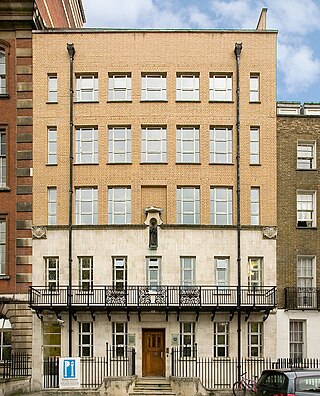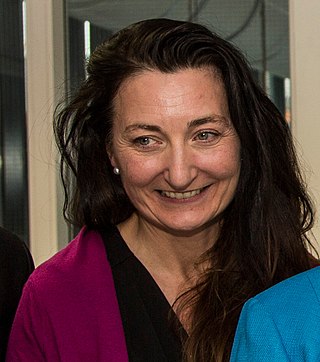
Peter Dayan is a British neuroscientist and computer scientist who is director at the Max Planck Institute for Biological Cybernetics in Tübingen, Germany. He is co-author of Theoretical Neuroscience, an influential textbook on computational neuroscience. He is known for applying Bayesian methods from machine learning and artificial intelligence to understand neural function and is particularly recognized for relating neurotransmitter levels to prediction errors and Bayesian uncertainties. He has pioneered the field of reinforcement learning (RL) where he helped develop the Q-learning algorithm, and made contributions to unsupervised learning, including the wake-sleep algorithm for neural networks and the Helmholtz machine.
The Gatsby Charitable Foundation is an endowed grant-making trust, based in London, founded by David Sainsbury in 1967. The organisation is one of the Sainsbury Family Charitable Trusts, set up to provide funding for charitable causes. Although the organisation is permitted in its Trust Deed to make general grants within this broad area, its activities have been restricted to a limited number of fields. At the time of writing, these fields are:

The Wellcome Centre for Human Neuroimaging at University College London is a world-leading interdisciplinary centre for neuroimaging research based in London, United Kingdom. Researchers at the Centre use expertise to investigate how the human brain generates behaviour, thoughts and feelings and how to use this knowledge to help patients with neurological and psychiatric disorders. Human neuroimaging allows scientists to non-invasively investigate the brain structure and functions including Action, Decision Making, Emotion, Hearing, Language, Memory, Navigation, Seeing, Self awareness, Social Behaviour and the Bayesian Brain

The Moser research environment is the informal name of a research environment established and led by the Nobel laureates Edvard Moser and May-Britt Moser at the Norwegian University of Science and Technology (NTNU) in Trondheim, Norway. The Mosers joined the university as professors of psychology in 1996, and formed their own neuroscience research group. The research group eventually evolved into several projects and research centers. The Mosers were awarded the 2014 Nobel Prize in Physiology or Medicine "for their discoveries of cells that constitute a positioning system in the brain."
UCL Neuroscience is a research domain that encompasses the breadth of neuroscience research activity across University College London's (UCL) School of Life and Medical Sciences. The domain was established in January 2008, to coordinate neuroscience activity across the many UCL departments and institutes in which neuroscience research takes place. In 2014, the Nobel Prize in Physiology or Medicine was awarded to the UCL neuroscientist John O'Keefe. In two consecutive years 2017 and 2018, the Brain Prize, the world's most valuable prize for brain research at €1m, was awarded to UCL neuroscientists Peter Dayan, Ray Dolan, John Hardy, and Bart De Strooper.

May-Britt Moser is a Norwegian psychologist and neuroscientist, who is a Professor of Psychology and Neuroscience at the Norwegian University of Science and Technology (NTNU). She and her then-husband, Edvard Moser, shared half of the 2014 Nobel Prize in Physiology or Medicine, awarded for work concerning the grid cells in the entorhinal cortex, as well as several additional space-representing cell types in the same circuit that make up the positioning system in the brain. Together with Edvard Moser she established the Moser research environment at NTNU, which they lead. Since 2012 she has headed the Centre for Neural Computation.
The UCL Faculty of Life Sciences is one of the 11 constituent faculties of University College London (UCL).

The UCL Queen Square Institute of Neurology is an institute within the Faculty of Brain Sciences of University College London (UCL) and is located in London, United Kingdom. Together with the National Hospital for Neurology and Neurosurgery, an adjacent facility with which it cooperates closely, the institute forms a major centre for teaching, training and research in neurology and allied clinical and basic neurosciences.

Eleanor Anne Maguire is an Irish neuroscientist. Since 2007, she has been Professor of Cognitive Neuroscience at University College London where she is also a Wellcome Trust Principal Research Fellow.

John O'Keefe, is an American-British neuroscientist, psychologist and a professor at the Sainsbury Wellcome Centre for Neural Circuits and Behaviour and the Research Department of Cell and Developmental Biology at University College London. He discovered place cells in the hippocampus, and that they show a specific kind of temporal coding in the form of theta phase precession. He shared the Nobel Prize in Physiology or Medicine in 2014, together with May-Britt Moser and Edvard Moser; he has received several other awards. He has worked at University College London for his entire career, but also held a part-time chair at the Norwegian University of Science and Technology at the behest of his Norwegian collaborators, the Mosers.

Michael A. Häusser FRS FMedSci is professor of Neuroscience, based in the Wolfson Institute for Biomedical Research at University College London (UCL).

The UCL Division of Psychology and Language Sciences is a Division within the Faculty of Brain Sciences of University College London (UCL) and is located in London, United Kingdom. The Division offers teaching and training and undertakes research in psychology and communication and allied clinical and basic science. It is the largest university psychology department in England.

Robin Angus Silver is Professor of Neuroscience and a Wellcome Trust Principal Research Fellow at University College London. His laboratory studies neurotransmission and artificial neural networks by combining in vitro and in vivo experimental approaches with quantitative analysis and computational models developed in silico.
Richard Edward Passingham is a British neuroscientist. He is an international authority on the frontal lobe mechanisms for decision making and executive control. He is amongst the most highly cited neuroscientists.

Dora Angelaki is a Professor of Neuroscience in the New York University Tandon School of Engineering. She previously held the Wilhelmina Robertson Professorship of Neuroscience at the Baylor College of Medicine. She looks at multi-sensory information flow between subcortical and cortical areas of the brain. Her research interests include spatial navigation and decision-making circuits. She was elected to the National Academy of Sciences in 2014.
Catherine J. "Cathy" Price is a British neuroscientist and academic. She is a professor of cognitive neuroscience and director of the Wellcome Trust Centre for Neuroimaging at University College London.
Claudia Clopath is a Professor of Computational Neuroscience at Imperial College London and research leader at the Sainsbury Wellcome Centre for Neural Circuits and Behaviour. She develops mathematical models to predict synaptic plasticity for both medical applications and the design of human-like machines.
Hugo Critchley is a British professor of psychiatry at Brighton and Sussex Medical School, a partnership of the University of Brighton and the University of Sussex.
Neuropixels probes are electrodes developed in 2017 to record the activity of hundreds of neurons in the brain. The probes are based on CMOS technology and have 1,000 recording sites arranged in two rows on a thin, 1-cm long shank.
Sonja Hofer is a German neuroscientist studying the neural basis of sensory perception and sensory-guided decision-making at the Sainsbury Wellcome Centre for Neural Circuits and Behaviour. Her research focuses on how the brain processes visual information, how neural networks are shaped by experience and learning, and how they integrate visual signals with other information in order to interpret the outside world and guide behaviour. She received her undergraduate degree from the Technical University of Munich, her PhD at the Max Planck Institute of Neurobiology in Martinsried, Germany, and completed a post doctorate at the University College London. After holding an Assistant Professorship at the Biozentrum University of Basel in Switzerland for five years, she now is a group leader and Professor at the Sainsbury Wellcome Centre for Neural Circuits and Behaviour since 2018.












